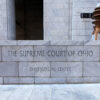The Securities and Exchange Commission on Wednesday adopted a final rule to require public companies to disclose climate-related information in financial statements and other reports provided to the commission.
The adopting release is 886 pages long and contains 3,241 footnotes. This rule will not do anything to protect investors. It will not do anything material to slow climate change. It will, however, enrich lawyers, accountants, climate change consultants, and left-wing nongovernmental organizations by requiring companies to spend billions of dollars to comply.
Many thousands of highly paid professionals will live off the rule’s complexity. The commission vote adopting the rule was 3-2. Commissioners Hester Peirce and Mark Uyeda dissented.
The proposed rule was, without question, the most destructive rule ever considered by the SEC. It would have quadrupled the cost of being a public company and had a highly detrimental impact on capital markets, investors and, because of the so-called Scope 3 reporting requirements, even small companies that have nothing to do with the stock market.
The proposed rule would have turned financial statements, quite literally, into works of fiction. Although highly counterproductive, the final rule is less destructive.
The undoubtedly optimistic SEC estimate is that the final rule will still raise internal costs by an astonishing 20% and external costs by 18%.
But at least the final rule will not require companies to include utterly fictitious and monumentally expensive reports in their financial statements regarding the greenhouse gas (GHG) emissions of their customers and suppliers. The SEC dropped “Scope 3” greenhouse gas emission reporting about the emissions of a reporting company’s customers and suppliers.
The final rule requires public companies to report their “Scope 1” and “Scope 2” emissions of greenhouse gases expressed in metric tons of carbon dioxide equivalent. Greenhouse gases are defined to include carbon dioxide, methane, nitrous oxide, nitrogen trifluoride, hydrofluorocarbons, perfluorocarbons, and sulfur hexafluoride.
Scope 1 emissions are direct greenhouse gas emissions from operations that are owned or controlled by the reporting company.
Scope 2 emissions are indirect emissions from the generation of purchased or acquired electricity, steam, heat, or cooling that is consumed by operations owned or controlled by a reporting company.
All of this is in addition to the existing EPA Greenhouse Gas Emissions Reporting Program that covers emissions from more than 8,000 facilities in the United States and about 85% to 90% percent of total emissions.
The rule also requires detailed reporting regarding oversight by the board of directors and management of climate-related risks, transition plans, scenario analysis, or internal carbon prices. It requires reporting information about a reporting company’s climate-related targets or goals, carbon offsets and renewable energy credits or certificates and a host of other matters.
It imposes requirements to report large amounts of immaterial information that has a trivial impact on company finances—but is of interest to climate activists. As Commissioner Peirce wrote in her dissent, “While the Commission has decorated the final rule with materiality ribbons, the rule embraces materiality in name only. The resulting flood of climate-related disclosures will overwhelm investors, not inform them.”
The rule explicitly creates a new profession. Firms must hire so-called “GHG emissions attestation providers.” These providers, in turn, will be certified by “oversight inspection programs” run by left-wing nongovernmental organizations. Those providers and NGOs will then become a potent lobby dedicated to preserving the SEC’s climate rule and the revenue stream of the attestation providers and NGOs.
The final rule will have a pronounced negative effect on entrepreneurs and average investors.
By increasing the cost of becoming a public company by at least 20%, it will make it more costly to access public capital markets. Fewer companies will be able to raise the capital needed to launch and grow, and they will do so later in their life-cycle.
That effect has been observed for the past two decades as the number of initial public offerings and the number of public companies declined because the regulatory burden on public companies steadily increased.
It also means that ordinary investors will have less opportunity to invest in successful, growing entrepreneurial ventures. Most of the profits will have been made while the company was still a private company. Access to private offerings by ordinary investors is generally barred by the SEC.
Implementation of the rule is phased in. Aspects of the rule will begin applying to large accelerated filers in 2025, accelerated filers in 2026, and smaller reporting companies and emerging growth companies in 2027. Compliance with all aspects of the rule will be required by 2033.
The first lawsuits challenging the rule have already been filed. In the coming weeks or months, the rule will be challenged in courtrooms across the country.
The changes made by the SEC to the proposed rule were designed primarily to make it more likely that the final rule will survive judicial review. Nevertheless, challenges to the final rule have a good chance of success.
That’s because the SEC is a securities regulator, not an environmental regulator. The requirements imposed by the final rule seriously stretch the statutory powers granted to the SEC.
So, a reasonable court could easily find that the SEC rule violates the Supreme Court’s major questions doctrine, which requires Congress to clearly authorize major regulatory initiatives.
Agencies may not seek to hide regulatory elephants in statutory mouseholes. Furthermore, the final rule is very nearly a total rewrite of the proposed rule. Very little of the original proposed rule survived without major changes.
As dissenting Commissioner Uyeda noted, “The Commission has essentially admitted that the proposal did not get it right.” Thus, because it is essentially a new rule, there is a strong argument that the rule should have been reproposed to provide the public with adequate notice and an opportunity to comment as is required by the Administrative Procedure Act.
Have an opinion about this article? To sound off, please email letters@DailySignal.com and we’ll consider publishing your edited remarks in our regular “We Hear You” feature. Remember to include the url or headline of the article plus your name and town and/or state.




























